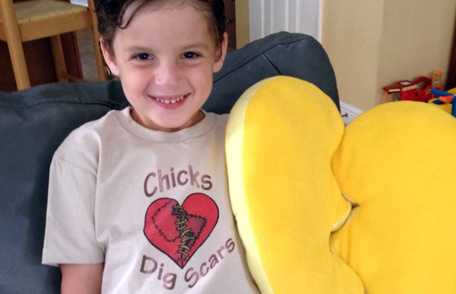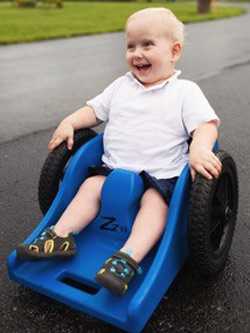Birth Defects: 1 in 33
 Did you know that birth defects affect one in every 33 babies born in the United States? That means about one child in every school classroom might be affected. Those are not just numbers—they represent real babies and families. Read these family stories to learn more about birth defects and how these conditions can impact lives.
Did you know that birth defects affect one in every 33 babies born in the United States? That means about one child in every school classroom might be affected. Those are not just numbers—they represent real babies and families. Read these family stories to learn more about birth defects and how these conditions can impact lives.
A birth defect diagnosis during pregnancy can challenge any family, but remaining hopeful can make a difference.
Dawn’s son, Caden, was born with hypoplastic left heart syndrome, a type of congenital heart defect (CHD). Dawn admits, receiving the diagnosis during pregnancy was both helpful and challenging.
It robbed me of any sort of normal pregnancy. After the diagnosis, we grieved a lot. Everything we had in our minds about this pregnancy went away. We had to prepare for a whole new pregnancy….That said, the diagnosis helped me prepare for what we needed to do. We researched what the defect was and what the prognosis would be. We tried to get all the best doctors on our case right from the beginning. We were also able to prepare our other children—we had to tell them that their sibling would not be coming home from the hospital right away.
In the end, Dawn wanted to share Caden’s story to help give other parents hope.
It’s a scary diagnosis, but so much of your baby’s success is your own attitude and how you approach the challenges. I remember when I was pregnant, I only saw one positive success story—one article where the baby was clapping and looked happy and healthy. It was a story about survival. I clipped it out, and it still resides in Caden’s baby book. Don’t lose sight of that hope.

Deborah’s twin daughters were born with craniosynostosis, a birth defect in which the bones in their skulls joined together too early.

“We learned that spina bifida is what Henry has – it will never define who he is.”
Connecting to care is vital for children with birth defects.
Deborah’s twin daughters were born with craniosynostosis, a birth defect in which the bones in their skulls joined together too early. Soon after their birth, Deborah and her family noticed that the appearance of their skulls seemed different. When the twins came home, they seemed unresponsive and floppy. Dawn followed her gut and remained persistent in asking her doctors and searching for information. Her persistence paid off and the girls got connected with the care and treatment they needed. Deborah describes how helpful her social worker was in connecting her family to local services:
She was the integral point of access for our family. She told us about Medicaid, Social Security, and early intervention. She really got the ball rolling for us. Through several moves across multiple states, she has helped me access and navigate different programs in the different places we lived. Through those experiences, I began to explore what worked for us and what didn’t. From that point on, my girls were getting the services they needed.
Birth defects don’t define one’s life.
Erin’s son, Henry, was born with spina bifida. When she learned of her son’s diagnosis, Erin didn’t know what to expect. In her search for information, she found and contacted a local chapter of the Spina Bifida Association. They invited her to attend a playgroup, where she and her husband met children living with spina bifida. Erin said, “The kids were doing all the things that, just a few weeks earlier, doctors said Henry would never do. We learned a lot about Henry that day. Even though we hadn’t met him yet, we learned that spina bifida is what Henry has – it will never define who he is.”
Henry is now almost three years old. Erin describes his progress, saying:
While things haven’t always been easy, he has proven doctors wrong time and time again. He isn’t walking yet, but he gets closer every day with lots of practice and the help of an amazing therapy team. But Henry has shown us that life isn’t lived only by those who are able to walk. He has shown us with unwavering spirit and determination that if you want something, you go get it, and you use what you have to get there… Yes, Henry has spina bifida, but it’s never going to be the coolest thing about him. He is able to live a life full of smiles, adventures, the very best giggles, and the ability to adapt where he needs to.
Awareness is key.
Have birth defects affected your life? Are you living with a heart defect? Are you the parent or sibling of a person living with spina bifida? Did your best friend or favorite aunt have a cleft lip or palate? Share your story on social media using the hashtag #1in33!
Even if you do not have a story to share, check out our family stories here and across social media to read about how birth defects affect people’s lives. Take a moment to learn more about how you can support a child or family living with a birth defect in your community. For National Birth Defects Prevention Month, join us in this nationwide effort to raise awareness of birth defects, their causes and their impact.
CDC would like to thank these families for sharing their stories!
For more information, visit Birth Defects.
- Page last reviewed: January 19, 2016
- Page last updated: January 19, 2016
- Content source:
- National Center on Birth Defects and Developmental Disabilities
- Page maintained by: Office of the Associate Director for Communication, Digital Media Branch, Division of Public Affairs




 ShareCompartir
ShareCompartir